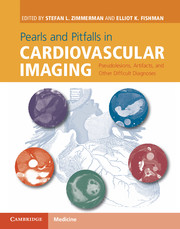 Pearls and Pitfalls in Cardiovascular Imaging
Pearls and Pitfalls in Cardiovascular Imaging from Section 2 - Cardiac aneurysms and diverticula
Published online by Cambridge University Press: 05 June 2015
Imaging description
The sinuses of Valsalva are focal expansions forming the walls of the aortic root. Sinus of Vasalva aneurysm (SVA) is a rare congenital anomaly with involvement of the right sinus in 65– 85% of instances, and less commonly originating from noncoronary (10–30%) and left sinuses (< 5%). Most SVA are congenital due to deficiency of the normal elastic tissue and abnormal development of the bulbus cordis. Acquired SVA can be seen with infective endocarditis, trauma, tuberculosis, and Behçet disease. Up to 21% of reported cases of SVA are clinically asymptomatic, and may be incidentally found at necropsy or during a diagnostic test for evaluation of unrelated non-cardiac or cardiac abnormalities. SVA are found in association with ventricular septal defects in 30–60% of patients. SVA can be identified on all modalities used for imaging the heart and aorta including catheter angiography, echocardiography, multidetector computed tomography (MDCT) and cardiac magnetic resonance (CMR). Currently transthoracic followed by transesophageal echocardiography is recommended for the initial assessment of both ruptured or nonruptured SVA, as they offer advantage in color flow and spectral Doppler to demonstrate the presence and direction of turbulent jets at the point of rupture. MDCT and CMR generate high-resolution multiplanar images to facilitate three-dimensional visualization and provide imaging of the coronary arteries, which is useful when surgical correction is being considered. On cardiac MRI, sinus of Valsalva aneurysms manifest as thin-walled outpouchings that are contiguous with the aortic root on sequential slices. Rupture can be identified by a turbulent flow jet from the sinus into the adjacent cardiac chamber on cine bright blood images. Large SVA can project into the right atrium and mimic an atrial mass, particularly if thrombosed (Figures 19.1 and 19.2). Partial or complete thrombosis is often seen with SVA due to blood stasis.
Importance
SVA may mimic a right-sided cardiac mass, particularly if thrombosed, which could lead to incorrect diagnosis and may alter surgical planning.
To save this book to your Kindle, first ensure [email protected] is added to your Approved Personal Document E-mail List under your Personal Document Settings on the Manage Your Content and Devices page of your Amazon account. Then enter the ‘name’ part of your Kindle email address below. Find out more about saving to your Kindle.
Note you can select to save to either the @free.kindle.com or @kindle.com variations. ‘@free.kindle.com’ emails are free but can only be saved to your device when it is connected to wi-fi. ‘@kindle.com’ emails can be delivered even when you are not connected to wi-fi, but note that service fees apply.
Find out more about the Kindle Personal Document Service.
To save content items to your account, please confirm that you agree to abide by our usage policies. If this is the first time you use this feature, you will be asked to authorise Cambridge Core to connect with your account. Find out more about saving content to Dropbox.
To save content items to your account, please confirm that you agree to abide by our usage policies. If this is the first time you use this feature, you will be asked to authorise Cambridge Core to connect with your account. Find out more about saving content to Google Drive.